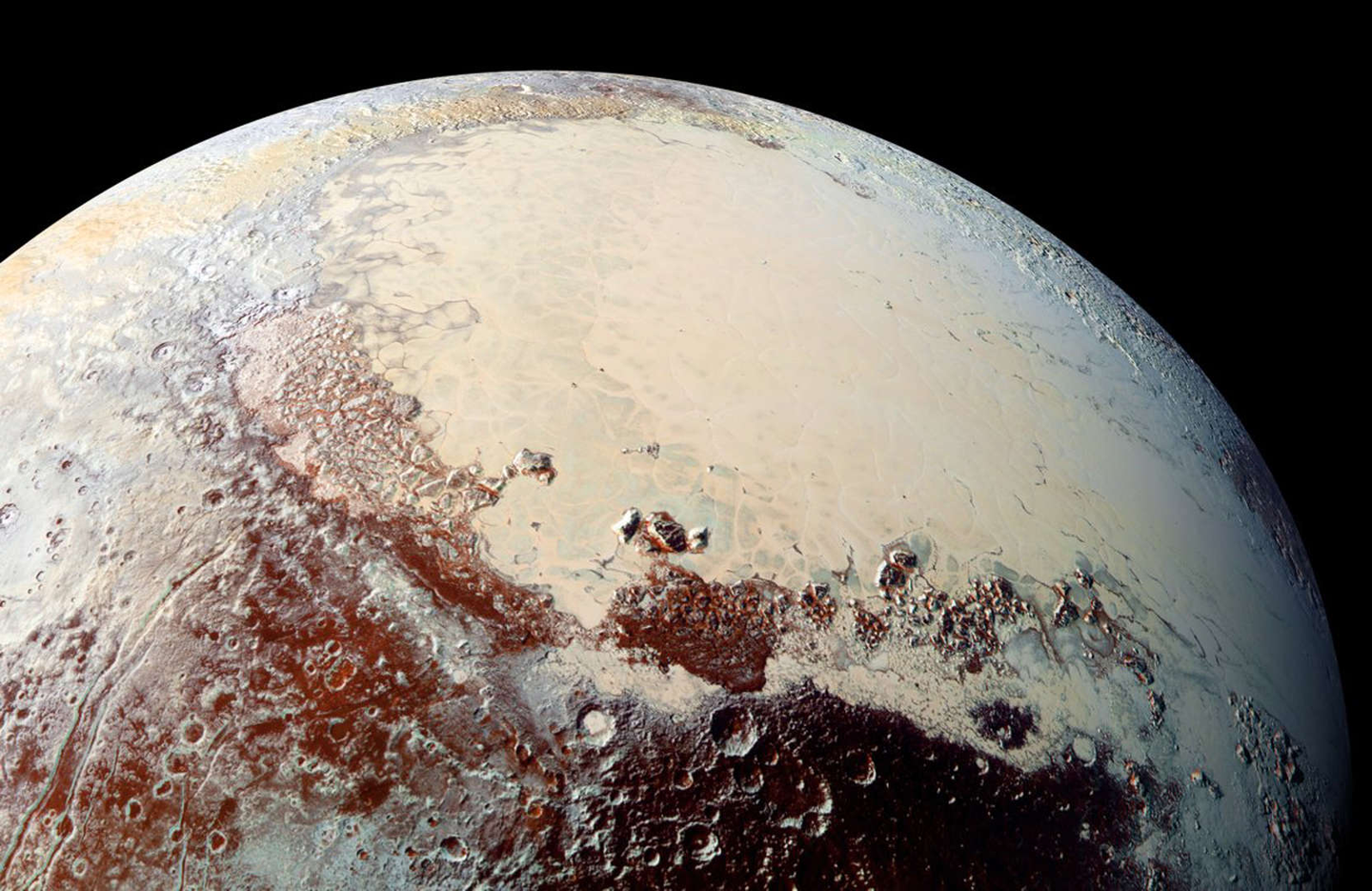Supervolcano leads to hidden ocean beneath the surface of Pluto
A crater near the iconic heart-shaped region on Pluto, known as Sputnik Planitia, has caught the attention of the scientific community

[Oct. 31, 2023: Staff Writer, The Brighter Side of News]
A view of Pluto's heart-shaped Sputnik Planitia as imaged by New Horizons spacecraft in 2015. (CREDIT: NASA)
Even after nearly ten years since NASA's New Horizons spacecraft paid its historic visit to Pluto, the distant dwarf planet never ceases to amaze us with its secrets. A recent discovery of an unusual crater has reignited the fascination scientists have for this remote celestial body, revealing its complex nature.
A curious crater near the iconic heart-shaped region on Pluto, known as Sputnik Planitia, has caught the attention of the scientific community.
This isn't just any regular crater. Researchers believe it might be a supervolcano that erupted a few million years ago. To put that into perspective, while a few million years sounds ancient, it's just a blip in cosmic time. The entire solar system, including our own Earth, has been around for more than 4.5 billion years!
A Different Kind of Volcano: The Phenomenon of Cryovolcanism
What sets this crater apart from terrestrial volcanoes is the substance it appears to have expelled. Named the Kiladze crater, this 44-km-wide formation seems to have released not molten rock, but rather a frigid substance referred to as "ice lava."
Related Stories
This phenomenon, known as cryovolcanism, isn't unique to Pluto and has been observed on moons orbiting our system's gas giants.
Cryovolcanism possibly pushed water from Pluto's subsurface oceans onto its exterior, changing the planet's landscape over millions of years. The existence of such volcanoes implies a surprising fact: there's still heat inside Pluto, defying previous assumptions about the dwarf planet's thermal state.
Cracking the Case: What Makes Kiladze Special?
New Horizons spacecraft had captured detailed images of the Kiladze crater. Initially, it seemed similar to craters resulting from meteorite collisions. However, upon closer observation, there was no central peak typically expected in such formations. The crater's slightly stretched shape suggests tectonic movements from within Pluto, further supporting the supervolcano hypothesis.
The global disk of Pluto showing major regions and locational context of the Kiladze (red outline). The highest resolution image of the region around Kiladze crater. (CREDIT: University of Central Florida)
Dale Cruikshank, the lead author of this study and a professor at the University of Central Florida, pointed out a distinct feature of Kiladze. Unlike most of Pluto's surface covered in methane and nitrogen ice, the area around this crater is abundant in water ice. This discovery is particularly intriguing, considering the icy exterior of Pluto, which is largely dominated by methane ice. "The water ice stands out clearly from the methane ice that covers much of the planet's surface," Cruikshank said.
Pluto's Unique Climate and the Methane Mystery
With its axis tilted at a stark 120 degrees, Pluto spins nearly on its side. This distinctive orientation causes dramatic climate shifts as the dwarf planet orbits the sun. Over time, methane ice transforms into a hazy atmosphere, eventually settling down as a snowy layer covering the planet.
A portion of the 1:7,000,000 scale geological map of Pluto (White et al., 2022), centered on Kiladze at 212.2°E, 28.2°N. North is up. (CREDIT: University of Central Florida)
Scientists estimate that over its 4.6-billion-year existence, Pluto's methane ice layer might have grown up to 46 feet thick. This methane blanket could form in merely three million years. Considering this, Cruikshank and his team deduced that the Kiladze crater could have been geologically active only a few million years ago.
The Unresolved Mystery
The exact mechanics of cryovolcanic activity on Pluto remain an enigma. Given its size, Pluto should've cooled down and lost its primordial heat ages ago. One theory suggests the presence of radioactive elements in its core, releasing heat as they decayed. However, some previous studies cast doubt on this idea, claiming there may not be sufficient amounts of these elements to maintain the heat.
2D visualization of digital elevation model (DEM) and a triangulated irregular network (TIN) contour map at Kiladze area and surroundings. (c, d) 3D visualization of base map and triangulated irregular network (TIN) map at Kiladze area and surrounding. (CREDIT: University of Central Florida)
Cruikshank speculates, "As the planet cooled, it is plausible that pockets of liquid water were left behind, and perhaps our eruptions of water onto the surface tap into those pockets." Yet, as with many of the universe's mysteries, there's still much we don't know.
This latest discovery underscores the immense intrigue and importance of studying celestial bodies like Pluto. With every piece of new information, we get closer to understanding the cosmos and our place in it. As the quest for knowledge continues, one thing remains clear: space never ceases to surprise and inspire.
For more science stories check out our New Discoveries section at The Brighter Side of News.
Note: Materials provided above by the The Brighter Side of News. Content may be edited for style and length.
Like these kind of feel good stories? Get the Brighter Side of News' newsletter.
Joseph Shavit
Head Science News Writer | Communicating Innovation & Discovery
Based in Los Angeles, Joseph Shavit is an accomplished science journalist, head science news writer and co-founder at The Brighter Side of News, where he translates cutting-edge discoveries into compelling stories for a broad audience. With a strong background spanning science, business, product management, media leadership, and entrepreneurship, Joseph brings a unique perspective to science communication. His expertise allows him to uncover the intersection of technological advancements and market potential, shedding light on how groundbreaking research evolves into transformative products and industries.



